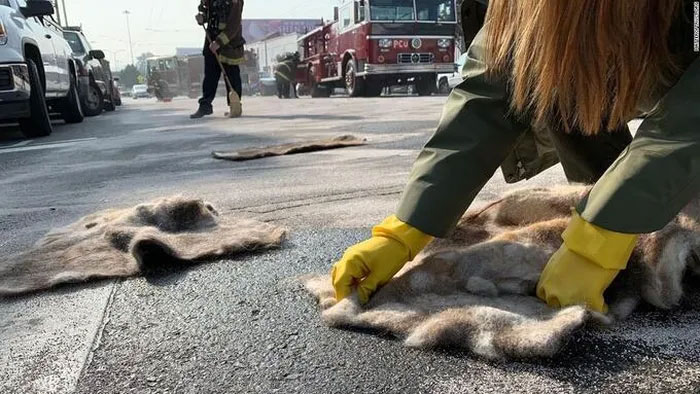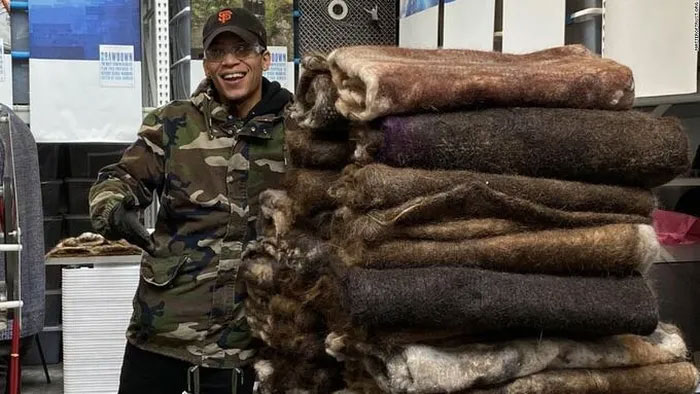Rugs made from hair can be used to clean up small oil spills after traffic accidents on roads or large oil spills at sea.
The Dangers of Oil Spills
Lisa Gautier, founder of the non-profit organization Matter of Trust (MOT) based in San Francisco, stated that the organization receives nearly a dozen bags of hair each day.

MOT volunteers using hair mats to clean oil on the road.
While hair may be considered waste by many, it is a treasure here. At MOT’s production facility, donated hair is transformed into mats that absorb oil spills on land or are used as booms to contain oil spills at sea.
Typically, polypropylene (PP) mats are used to clean oil on land. However, PP plastic is not biodegradable, and producing PP requires extracting more oil. In contrast, hair is an environmentally friendly resource that can absorb up to five times its weight in oil and is abundantly available.
“There are about 900,000 licensed hair salons operating in the U.S. Each salon can easily collect at least 1 pound of hair per week (0.45 kg),” Gautier noted.
Gautier added: “Using a renewable natural resource to clean up oil spills is much more meaningful than using more oil to clean it.”
Oil spills can contaminate drinking water sources, pose public health risks, harm wildlife, and damage the economy.
In 2021, the National Oceanic and Atmospheric Administration (NOAA) recorded 175 oil spill incidents on land and at sea in the United States alone. It is estimated that globally, around 10,000 tons of oil have been released into the environment due to oil tanker spills.
According to MOT, just 1 liter of oil entering a water supply can contaminate 1 million gallons (4.5 million liters) of drinking water. So far this year, there have been significant oil spills in Thailand and Peru, with the estimated amount of spilled oil exceeding 500,000 gallons (2.2 million liters).
Gautier mentioned that oil spill incidents account for only about 5% of global oil pollution. More common sources of pollution include leaks from road vehicles seeping into the ground or oil leaking from the ocean floor.
The Hair Mat Movement Expands

Hair mats bundled together to deal with oil leaks from vehicles.
Gautier and her husband, Patrice Gautier, founded MOT in 1998 to address a range of environmental issues. Three years later, a tanker ran aground in San Cristobal, and the Gautiers collaborated with hairstylist Philip McCrory to assist in the oil spill cleanup.
Previously, in 1989, McCrory designed a prototype device that used hair to absorb oil. This device was tested by NASA and performed well. Consequently, MOT partnered with McCrory to develop booms and mats made from hair.
Every day, hair salons, pet stores, and individuals send hair to MOT’s warehouse in San Francisco. The packages are checked for contaminants such as debris, dirt, or lice. The hair is separated and spread onto a frame, then processed through a specialized device to create mats.
To produce a mat measuring 0.6m2 and approximately 2.5cm thick, about 0.5kg of hair is needed. This mat can absorb up to 5.6 liters of oil.
Most of MOT’s oil cleanup efforts occur on land or at coastal oil spills. The organization reports that about half of their products are purchased by entities such as the U.S. Air Force and government agencies; the other half is donated to volunteer cleanup crews.
According to Gautier, MOT has produced over 300,000 oil-absorbing booms and more than 40,000 hair mats to clean up everything from small leaks to large oil spills, including the Deepwater Horizon oil rig explosion that released 160 million gallons of oil into the Gulf of Mexico in April 2010.

Hair collected and sent to MOT’s production facility to create oil-absorbing mats.
According to environmental biologist Megan Murray, Deputy Vice-Chancellor of the University of Technology Sydney (Australia), the effectiveness of hair compared to PP is comparable and in some cases even better.
“Hair mats are very effective in dealing with oil spills on land, but if crude oil spills onto sandy beaches, it is very difficult to absorb the oil with any material, whether it is PP or human hair,” the Deputy Vice-Chancellor stated.
Murray noted that the biggest advantage of hair mats is their low cost and accessibility, but they are not a perfect solution as they can only be used once. After use, hair mats must be disposed of by burning or composting in the ground. This soil can no longer be used for growing food crops. Currently, Murray is researching methods to extract oil from used hair mats and to reuse both the mats and the oil.
MOT is currently expanding its network of partners in 17 countries worldwide. Partner centers can retain a small portion of profits to implement larger projects. Since the designs are not patented, many other organizations and groups have begun producing their own oil-absorbing mats and booms. Nevertheless, Gautier is pleased to see this movement spreading.
“Anyone can make hair mats. It creates jobs, cleans water sources, reduces waste in landfills, and promotes renewable resources,” Gautier stated.


















































